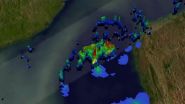(Press-News.org) [EMBARGOED UNTIL THURSDAY, APRIL 3] Patients' risk of stroke significantly increased following the first signs of shingles, but antiviral drugs appeared to offer some protection, according to a new study in Clinical Infectious Diseases, now available online. People with shingles, an often painful skin rash caused by the same virus that causes chickenpox, had a higher stroke risk in the first 6 months after shingles symptoms appeared; this risk was particularly increased in patients with a rash near their eyes, the study found.
Shingles, or herpes zoster, is a significant public health problem, affecting an estimated 1 million adults in the U.S. and nearly 90,000 in the U.K. each year. The disease develops when the varicella-zoster virus, which causes chickenpox in children and then remains dormant in the body, reactivates later in life.
Sinéad Langan, MD, PhD, and colleagues at the London School of Hygiene & Tropical Medicine identified patients with first-ever incidents of shingles and stroke, and also examined antiviral treatment records for shingles, drawing from a database of information from patients across 600 general practices in the U.K.
Researchers compared the risk of stroke in the time period after the patient had shingles to time periods when the patient did not have recent shingles. Among the 6,584 patients included in the study, the stroke rate was 63 percent higher in the first four weeks after a shingles episode compared to the patient's baseline risk, diminishing slowly up to 6 months later. The stroke risk increased up to three-fold for a short period of time among those with a shingles rash affecting the skin around their eyes, compared to baseline risk.
In patients treated with oral antiviral medication for their shingles—55 percent of study participants—the risk of stroke was lower than in those not treated with antivirals. "The relatively low prescribing rates of antiviral therapy in U.K. general practice after developing shingles need to be improved," Dr. Langan said, "as our study suggests that stroke risks following shingles are lower in those treated with oral antiviral therapy compared to individuals not treated with antiviral therapy."
The findings also highlight the importance of vaccinating older adults against shingles, which can reduce the risk of developing the painful condition in the first place. A shingles vaccine is available and recommended for adults over 60 in the U.S. and for those in their 70s in the U.K.
In a related editorial, Maria A. Nagel, MD, and Donald H. Gilden, MD, of the University of Colorado School of Medicine, noted that the findings confirm previous studies of shingles and stroke risk from Taiwan, Denmark, and the U.K. This latest study is "the first to show that the increased risk of stroke after zoster can be reduced with antiviral treatment," they wrote.
INFORMATION:
Editor's note: The research was funded by the U.K.'s National Institute for Health Research (NIHR) and the Stroke Association. The views expressed are those of the author(s) and not necessarily those of the funders, the U.K. National Health Service (NHS), or the U.K. Department of Health.
Fast Facts:
1. An often painful skin rash, shingles (herpes zoster) affects an estimated 1 million adults in the U.S. and nearly 90,000 in the U.K. each year.
2. People with shingles, particularly those with a rash near their eyes, had a higher stroke risk in the first 6 months after their symptoms appeared, this study found.
3. Antiviral treatment for shingles appeared to lower this increased risk of stroke.
Clinical Infectious Diseases is a leading journal in the field of infectious disease with a broad international readership. The journal publishes articles on a variety of subjects of interest to practitioners and researchers. Topics range from clinical descriptions of infections, public health, microbiology, and immunology to the prevention of infection, the evaluation of current and novel treatments, and the promotion of optimal practices for diagnosis and treatment. The journal publishes original research, editorial commentaries, review articles, and practice guidelines and is among the most highly cited journals in the field of infectious diseases. Clinical Infectious Diseases is an official publication of the Infectious Diseases Society of America (IDSA). Based in Arlington, Va., IDSA is a professional society representing nearly 10,000 physicians and scientists who specialize in infectious diseases. For more information, visit http://www.idsociety.org. Follow IDSA on Facebook and Twitter.
Stroke risk higher after shingles, but antiviral drugs may provide protection
Study finds increased risk of stroke following shingles, suggests antiviral treatment may
2014-04-03
ELSE PRESS RELEASES FROM THIS DATE:
A brain region for resisting alcohol's allure
2014-04-03
As recovering spring breakers are regretting binge drinking escapades, it may be hard for them to appreciate that there is a positive side to the nausea, sleepiness, and stumbling. University of Utah neuroscientists report that when a region of the brain called the lateral habenula is chronically inactivated in rats, they repeatedly drink to excess and are less able to learn from the experience. The study, published online in PLOS ONE on April 2, has implications for understanding behaviors that drive alcohol addiction.
While complex societal pressures contribute to alcoholism, ...
Magnetic anomaly deep within Earth's crust reveals Africa in North America
2014-04-02
Boulder, Colo., USA – The repeated cycles of plate tectonics that have led to collision and assembly of large supercontinents and their breakup and formation of new ocean basins have produced continents that are collages of bits and pieces of other continents. Figuring out the origin and make-up of continental crust formed and modified by these tectonic events is a vital to understanding Earth's geology and is important for many applied fields, such as oil, gas, and gold exploration.
In many cases, the rocks involved in these collision and pull-apart episodes are still ...
NASA releases images of M-class solar flare
2014-04-02
On April 2, 2014, the sun emitted a mid-level solar flare, peaking at 10:05 a.m. EDT, and NASA's Solar Dynamics Observatory captured imagery of the event. Solar flares are powerful bursts of radiation. Harmful radiation from a flare cannot pass through Earth's atmosphere to physically affect humans on the ground, however -- when intense enough -- they can disturb the atmosphere in the layer where GPS and communications signals travel.
To see how this event may impact Earth, please visit NOAA's Space Weather Prediction Center at http://spaceweather.gov, the U.S. government's ...
NASA sees Tropical Cyclone's Hellen's lively remnants
2014-04-02
Powerful Tropical Cyclone Hellen rapidly weakened after hitting northwestern Madagascar but Hellen's remnants have recently started to show signs of life. The TRMM satellite flew over these remnants in the Mozambique Channel on April 2, 2014 at 0143 UTC.
A rainfall analysis using the Tropical Rainfall Measuring Mission's (TRMM) Microwave Imager (TMI) and Precipitation Radar (PR) instruments found that some strong convective thunderstorms had developed in the area. It was revealed by TRMM PR data that rain was falling at a rate of over 75 mm/~ 3 inches in a few locations.
TRMM's ...
River ice reveals new twist on Arctic melt
2014-04-02
A new study led by Lance Lesack, a Simon Fraser University geographer and Faculty of Environment professor, has discovered unexpected climate-driven changes in the mighty Mackenzie River's ice breakup. This discovery may help resolve the complex puzzle underlying why Arctic ice is disappearing more rapidly than expected.
Lesack is the lead author on Local spring warming drives earlier river-ice breakup in a large Arctic delta. Published recently in Geophysical Research Letters, the study has co-authors at Wilfrid Laurier University, the University of Alberta and Memorial ...
Body odor changes following vaccination
2014-04-02
PHILADELPHIA (April 2, 2014) – Our understanding of the role of body odor in conveying personal information continues to grow. New research from the Monell Chemical Senses Center and the U.S. Department of Agriculture (USDA) reveals that immunization can trigger a distinct change in body odor. This is the first demonstration of a bodily odor change due to immune activation.
The findings will appear in the April 10 issue of Physiology and Behavior. In addition, portions of the work will be presented on April 10 at the 36th Annual Meeting of the Association for Chemoreception ...
Science-themed music videos boost scientific literacy, study shows
2014-04-02
As the United States puts ever-greater emphasis on science, technology, engineering and mathematics education to keep competitive in the global economy, schools are trying to figure out how to improve student learning in science.
University of Washington researchers Katie Davis and Greg Crowther think music may be the answer for some kids. They studied the ability of music videos to enhance students' understanding of scientific concepts.
Davis will present "Sing about Science: Leveraging the Power of Music to Improve Science Education" on Friday (April 4) at the American ...
Gauging the impact of tropical forest logging: Winrock develops new method for quantifying carbon emissions
2014-04-02
ARLINGTON, Va. (April 2, 2014) — Researchers at Winrock International have developed a first-of-its-kind method for estimating carbon emissions from forest degradation caused by selective logging in tropical regions. Refined over a period of 15 years and tested in six countries, the approach is highlighted in an article authored by Winrock's Ecosystems Services experts, Timothy Pearson, Sandra Brown and Felipe Casarim — published April 1 in Environmental Research Letters.
Until now, efforts for reducing emissions from deforestation and forest degradation (REDD+) in developing ...
NIST's simple microfluidic devices now have valves
2014-04-02
Researchers at the National Institute of Standards and Technology (NIST) have added yet another innovation—miniature valves—to their ever-growing collection of inexpensive, easy-to-manufacture and highly efficient microfluidic devices made from plastic films and double-sided tape.
Traditionally, microfluidic devices—tiny gadgets with fluid-carrying channels used in medical diagnostics, DNA forensics and "lab-on-a-chip" chemical analyzers—have been fabricated like microchips using photolithography. A desired pattern of micrometer-sized channels and ports is created on ...
To boldly go? Experts issue ethics guidelines for NASA's next generation of risky missions
2014-04-02
Nearly two years after the conclusion of its space shuttle program left Americans wondering what would become of the spacefaring dreams of decades past, NASA has sought the advice of health and ethics experts for protecting astronauts on its "next generation" of long duration and exploration-class human spaceflights.
Such missions, including extended stays on the International Space Station and flights to Mars, have higher risks and are unlikely to meet the space agency's current health standards. Options not on the table, according to the Institute of Medicine (IOM) ...
LAST 30 PRESS RELEASES:
Making lighter work of calculating fluid and heat flow
Normalizing blood sugar can halve heart attack risk
Lowering blood sugar cuts heart attack risk in people with prediabetes
Study links genetic variants to risk of blinding eye disease in premature infants
Non-opioid ‘pain sponge’ therapy halts cartilage degeneration and relieves chronic pain
AI can pick up cultural values by mimicking how kids learn
China’s ecological redlines offer fast track to 30 x 30 global conservation goal
Invisible indoor threats: emerging household contaminants and their growing risks to human health
Adding antibody treatment to chemo boosts outcomes for children with rare cancer
Germline pathogenic variants among women without a history of breast cancer
Tanning beds triple melanoma risk, potentially causing broad DNA damage
Unique bond identified as key to viral infection speed
Indoor tanning makes youthful skin much older on a genetic level
Mouse model sheds new light on the causes and potential solutions to human GI problems linked to muscular dystrophy
The Journal of Nuclear Medicine ahead-of-print tip sheet: December 12, 2025
Smarter tools for peering into the microscopic world
Applications open for funding to conduct research in the Kinsey Institute archives
Global measure underestimates the severity of food insecurity
Child survivors of critical illness are missing out on timely follow up care
Risk-based vs annual breast cancer screening / the WISDOM randomized clinical trial
University of Toronto launches Electric Vehicle Innovation Ontario to accelerate advanced EV technologies and build Canada’s innovation advantage
Early relapse predicts poor outcomes in aggressive blood cancer
American College of Lifestyle Medicine applauds two CMS models aligned with lifestyle medicine practice and reimbursement
Clinical trial finds cannabis use not a barrier to quitting nicotine vaping
Supplemental nutrition assistance program policies and food insecurity
Switching immune cells to “night mode” could limit damage after a heart attack, study suggests
URI-based Global RIghts Project report spotlights continued troubling trends in worldwide inhumane treatment
Neutrophils are less aggressive at night, explaining why nighttime heart attacks cause less damage than daytime events
Menopausal hormone therapy may not pose breast cancer risk for women with BRCA mutations
Mobile health tool may improve quality of life for adolescent and young adult breast cancer survivors
[Press-News.org] Stroke risk higher after shingles, but antiviral drugs may provide protectionStudy finds increased risk of stroke following shingles, suggests antiviral treatment may




